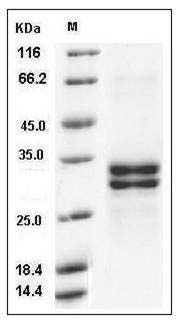-
Product Name
Human HMGB1/HMG1 (His Tag) recombinant protein
- Documents
-
Description
High-mobility group box 1 protein (HMGB1), also known as HMG-1 or amphoterin previously, is a member of the HMGB family consisting of three members, HMGB1, HMGB2 and HMGB3. HMGB1 is a DNA-binding nuclear protein, released actively following cytokine stimulation as well as passively during cell death. It is the prototypic damage-associated molecular pattern (DAMP) molecule and has been implicated in several inflammatory disorders. HMGB1 signals via the receptor for advanced glycation end-product (RAGE) and members of the toll-like receptor (TLR) family. The most prominent HMGB1 protein and mRNA expression arthritis is present in pannus regions, where synovial tissue invades articular cartilage and bone. HMGB1 promotes the activity of proteolytic enzymes, and osteoclasts need HMGB1 for functional maturation. As a non-histone nuclear protein, HMGB1 has a dual function. Inside the cell, HMGB1 binds DNA, regulating transcription and determining chromosomal architecture. Outside the cell, HMGB1 can serve as an alarmin to activate the innate system and mediate a wide range of physiological and pathological responses. Extracellular HMGB1 represents an optimal "necrotic marker" selected by the innate immune system to recognize tissue damage and initiate reparative responses. However, extracellular HMGB1 also acts as a potent pro-inflammatory cytokine that contributes to the pathogenesis of diverse inflammatory and infectious disorders. HMGB1 has been successfully therapeutically targeted in multiple preclinical models of infectious and sterile diseases including arthritis. As shown in studies on patients as well as animal models, HMGB1 can play an important role in the pathogenesis of rheumatic disease, including rheumatoid arthritis, systemic lupus erythematosus, and polymyositis among others. In addition, enhanced postmyocardial infarction remodeling in type 1 diabetes mellitus was partially mediated by HMGB1 activation.
-
Protein name
High mobility group protein B1
-
Protein short names
MGC117897; P30; MGC117896; DKFZP686A04236; MGC103168; MGC103169; AMPHOTERIN; HMG1; HMGB1; MCG_144566; DEF; SBP-1; HMG3; HMG-1
-
Uniprot ID
P09429
-
Gene Name
HMGB1; HMG1
-
Source/Expression Host
Human Cells
-
Expression Plasmid/cDNA
A DNA sequence encoding the human HMGB1 protein (NP_002119.1) (Met 1-Glu 215) was fused with a polyhistidine tag at the C-terminus and a signal peptide at the N-terminus.
-
Protein Species
Human
-
Molecular weight
The recombinant human HMGB1 consists of 226 amino acids and has a predicted molecular mass of 26.3 kDa. As a result of glycosylation, the apparent molecular mass of rhHMGB1 is approximately 30-34 kDa in SDS-PAGE under reducing conditions.
-
Purity
> 93 % as determined by SDS-PAGE
-
Activity
Measured by its binding ability in a functional ELISA. Immobilized human HMGB at 2 μg/ml (100 μl/well) can bind human AGER. The EC50 of human AGER is 0.27 μg/ml.
-
Validations

Human HMGB1 / HMG1 Protein (His Tag) SDS-PAGE
Related Products / Services
Please note: All products are "FOR RESEARCH USE ONLY AND ARE NOT INTENDED FOR DIAGNOSTIC OR THERAPEUTIC USE"
